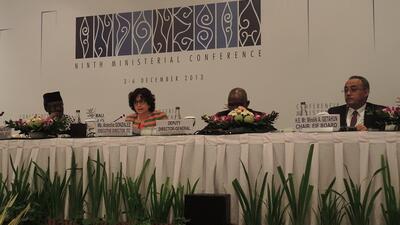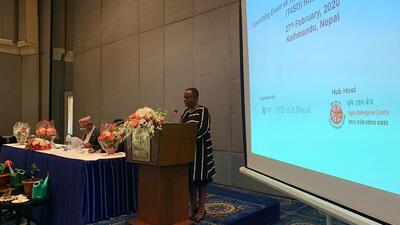

Making markets work for home-based workers in Nepal
Scaling up skills and product design is empowering marginalized women to enter regional and global markets
Home-based workers (HBWs) are vital to Nepal’s economy, comprising about one-third of its non-agricultural labour force. The contributions they make to the country’s economy cannot be discounted because they are in the informal sector. By producing products that are mostly exported, they contribute directly to GDP and to the preservation of cultural heritage.
These factors are often not realized by the government, resulting in a lack of proper policies to address the grievances of marginalized women. This becomes even more of an issue when considering the number of women HBWs compared to men. The proportion of women involved in home-based work is much higher than that of men: almost half of women non-agricultural workers are home-based versus just over one-fifth of men.
More rural people are dependent on home-based work as a source of livelihood than in Nepal’s urban areas: one-third of the non-agricultural workers in rural areas were home-based in comparison to around 22% in urban areas. Furthermore, over half of all women in non-agricultural work are employed as HBWs in rural areas in comparison to just over a third in urban areas.
In Nepal, women home-based work is mostly based on the inherited skills such as handloom weaving, knitting, yarn-making and other traditional handicrafts. The lack of proper skills or education to enter the formal workforce is often the main reason for women to choose this form of work. Another important factor is the responsibility of household work and care of their children and family.
These factors are often not realized by the government, resulting in a lack of proper policies to address the grievances of marginalized women.
The fact that women work from home renders such workers invisible and isolated. They are therefore likely to be less well-organized and have less of a voice compared to workers in the formal sector. Being invisible also makes women HBWs more vulnerable to exploitation.
Middlemen or intermediaries often exploit them by paying low piece rates and low remuneration as they lack direct market access. The invisibility or the lack of recognition as workers makes it impossible for them to enjoy any sort of employment-based benefits or social protection. In fact, women HBWs themselves remain uncounted and undercounted.
Some other problems faced by women HBWs range from the lack of market access, and inadequate managerial skills to the lack of technical skills to produce market-oriented products. Properly channelling their abilities into entrepreneurship through appropriate and cost-effective business development support services has the potential to impact a rural economy by generating employment and increasing income.
Since its establishment, SABAH Nepal has been zeroing in on its mission of empowering rural and urban women HBWs of the informal sector through economic self-sufficiency. To achieve this goal, it identifies and brings together local women HBWs and artisans to give them collective bargaining power. SABAH also empowers women through intensive training in enhanced production techniques, exposure visits, market awareness and other capacity-building programmes. They are also provided with a range of business-development inputs including market readiness, research and development, market linkages and intelligence, quality standardization and product development.
SABAH Nepal has been creating work opportunities by providing skills and the necessary support systems. As the HBWs are enabled to produce marketable and competitive goods there is a significant increase in their incomes.
SABAH Nepal’s Trade Facilitation Centre acts as a hub for all these activities, thereby providing a vital link to HBW clusters and Common Facilitation Centres (CFCs) working in the value chain. It also provides a permanent marketing network for its members by ensuring that artisanal products are ready for local and foreign markets.
The Trade Facilitation Centre builds relationships with trading houses, customers and buyers. It markets products through annual exhibitions, SABAH Nepal’s retail network, shop-in-shops and an online portal under the brand SABAH. It has organized several brand-building events, which has created demand for various product lines not only within the country but also in the global market.
The local Common Facilitation Centres established in various rural areas strengthen the value chain of numerous products under the SABAH brand. They are equipped with small-scale technology so that they can produce goods utilizing local resources in a cost-effective and efficient manner. The CFCs also focus strengthening the training of existing artisans.
The final outcomes of such interventions are that women HBWs are capable of making products that can compete in local and global markets. By making the market work for these rural workers, SABAH Nepal’s model could set an example, thereby contributing to the reduction of poverty.








